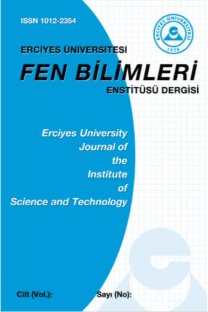Boronik Asit İçeren Zirkonyum Esaslı Metal-Organik Kafes Yapıların Üretimi ve Şeker Molekülü Yakalama Kapasitelerinin Belirlenmesi
Karışım-ligant sentez metoduyla işlevselleştirilen metal-organik kafes (MOF) yapılar çeşitli alanlarda büyük ilgi görmektedir. Bu çalışmada karışım-ligant metodu kullanılarak zirkonyum (Zr) esaslı UiO-66 yapısına 4-karboksifenil boronik asit ligantları dahil edilerek, gözenek yüzeylerinde serbest halde boronik asit –B(OH)2 fonksiyonel grupları bulunan Zr-MOF’lar başarılı bir şekilde sentezlendi. Çalışmada elde edilen MOF’ların kristal yapıları ve kompozisyonları PXRD, FTIR, 1H-NMR ölçümleri ile aydınlatıldı. Sıvı azot sıcaklığında azot gazı adsorpsiyon ölçümleri yapılan MOF’ların yüzey alanları BET teorisine göre ve gözenek boyutları ise NLDFT teorisine göre hesaplandı. Elde edilen bütün MOF yapılarının aktive edildikten sonra cis-diol içeren şeker moleküllerini (glikoz, früktoz, galaktoz ve ksiloz) tutma kapasiteleri HPLC ile ölçüldü. Boronik asit içeren UİO-66B yapılarının, işlevselleştirilmemiş UiO-66 yapısına göre boronik asit ve şeker molekülleri arasındaki kovalent etkileşimler nedeniyle daha iyi şeker tutma kapasitlerinin olduğu gözlendi. Şeker tutma kapasitelerinin yapıda artan boronik asit oranı ve ortamın pH’ının yükselmesiyle arttığı görüldü.
Anahtar Kelimeler:
Metal-Organik Kafes Yapılar, Cis-diol, Adsorpsiyon, Şeker Molekülleri
___
- [1] R.Q. Zhang, Z. Wang, T.F. Wang, P. Su, Y. Yang, Boronic acid-decorated metal-organic frameworks modified via a mixed-ligand strategy for the selective enrichment of cis-diol containing nucleosides, Anal Chim Acta 1106 (2020) 42-51.
- [2] G.S. Chen, X.A. Fang, Q. Chen, J.G. Zhang, Z.S. Zhong, J.Q. Xu, F. Zhu, G.F. Ouyang, Boronic Acid Decorated Defective Metal-Organic Framework Nanoreactors for High-Efficiency Carbohydrates Separation and Labeling, Adv Funct Mater 27(38) (2017) 1702126.
- [3] H. Furukawa, K.E. Cordova, M. O'Keeffe, O.M. Yaghi, The Chemistry and Applications of Metal-Organic Frameworks, Science 341(6149) (2013) 974.
- [4] H. Li, K.C. Wang, Y.J. Sun, C.T. Lollar, J.L. Li, H.C. Zhou, Recent advances in gas storage and separation using metal-organic frameworks, Mater Today 21(2) (2018) 108-121.
- [5] L.T. Liu, Y.L. Zhou, S. Liu, M.T. Xu, The Applications of Metal-Organic Frameworks in Electrochemical Sensors, Chemelectrochem 5(1) (2018) 6-19.
- [6] C.Y. Gao, J. Ai, H.R. Tian, D. Wu, Z.M. Sun, An ultrastable zirconium-phosphonate framework as bifunctional catalyst for highly active CO2 chemical transformation, Chem Commun 53(7) (2017) 1293-1296.
- [7] K. Zhan, Y.B. Zhu, J. Yan, Y.L. Chen, Enhanced-performance relative humidity sensor based on MOF-801 photonic crystals, Phys Lett A 384(26) (2020) 126678.
- [8] J. Yang, Y.W. Yang, Metal-Organic Frameworks for Biomedical Applications, Small 16(10) (2020) 1906846.
- [9] M. Erkartal, U. Sen, Boronic Acid Moiety as Functional Defect in UiO-66 and Its Effect on Hydrogen Uptake Capacity and Selective CO2 Adsorption: A Comparative Study, Acs Appl Mater Inter 10(1) (2018) 787-795.
- [10] X.Y. Zhu, J.L. Gu, J.Y. Zhu, Y.S. Li, L.M. Zhao, J.L. Shi, Metal-Organic Frameworks with Boronic Acid Suspended and Their Implication for cis-Diol Moieties Binding, Adv Funct Mater 25(25) (2015) 3847-3854.
- [11] J.H. Cavka, S. Jakobsen, U. Olsbye, N. Guillou, C. Lamberti, S. Bordiga, K.P. Lillerud, A new zirconium inorganic building brick forming metal organic frameworks with exceptional stability, J Am Chem Soc 130(42) (2008) 13850-13851.
- [12] C.H. Wang, X.L. Liu, J.P. Chen, K. Li, Superior removal of arsenic from water with zirconium metal-organic framework UiO-66, Sci Rep-Uk 5 (2015) 16613.
- [13] Y. Wang, L.L. Lu, H. Peng, J. Xu, F.Y. Wang, R.J. Qi, Z.A. Xu, W. Zhang, Multi-doped carbon dots with ratiometric pH sensing properties for monitoring enzyme catalytic reactions, Chem Commun 52(59) (2016) 9247-9250.
- [14] S.W. Oh, J.W.E. Weiss, P.A. Kerneghan, I. Korobkov, K.E. Maly, D.L. Bryce, Solid-state 11B and 13C NMR, IR, and X-ray crystallographic characterization of selected arylboronic acids and their catechol cyclic esters, Magn Reson Chem 50(5) (2012) 388-401.
- [15] M. Shimomura, B. Ono, K. Oshima, S. Miyauchi, Complexation of sugars with dihydroxyborylphenyl groups attached to magnetite particles via graft polymerization of acrylic acid, Polymer 47(16) (2006) 5785-5790.
- [16] C.C. Lu, H.Y. Li, H.Y. Wang, Z. Liu, Probing the Interactions between Boronic Acids and cis-Diol-Containing Biomolecules by Affinity Capillary Electrophoresis, Anal Chem 85(4) (2013) 2361-2369.
- [17] X.Y. Li, H.C. Zhang, P.Y. Wang, J. Hou, J. Lu, C.D. Easton, X.W. Zhang, M.R. Hill, A.W. Thornton, J.Z. Liu, B.D. Freeman, A.J. Hill, L. Jiang, H.T. Wang, Fast and selective fluoride ion conduction in sub-1-nanometer metal-organic framework channels, Nat Commun 10 (2019) 2490.
- [18] K. Singh, S. Mohan, Adsorption behavior of selected monosaccharides onto an alumina interface, J Colloid Interf Sci 270(1) (2004) 21-28.
- [19] G.T. Williams, J.L. Kedge, J.S. Fossey, Molecular Boronic Acid-Based Saccharide Sensors, Acs Sensors 6(4) (2021) 1508-1528
- ISSN: 1012-2354
- Yayın Aralığı: Yılda 3 Sayı
- Başlangıç: 1985
- Yayıncı: Erciyes Üniversitesi
Sayıdaki Diğer Makaleler
Üç Boyutlu Tetrakis Hexahedron Uzayında Küresel İnversiyonlar Üzerine
Theoretical and Vibrational Analysis of Substituted Hydrazones: Valence Force Field
Maden-Ergani Bakır İşletmesi Yerleşkesinde Yer Alan Konut Yapılarının Mekânsal Analizi
Sismik İzolasyonlu Yapıların Tasarımında Kullanılan Analiz Yöntemlerinin Karşılaştırılması
Yönsel Türev Tabanlı Yakınsama Yaklaşımlarının Karşılaştırmalı Analizi
Ersan YAZAN, Muhammed Fatih TALU
Dördüncü Mertebeden Diferensiyel Denklemler için Salınım Kriterleri
